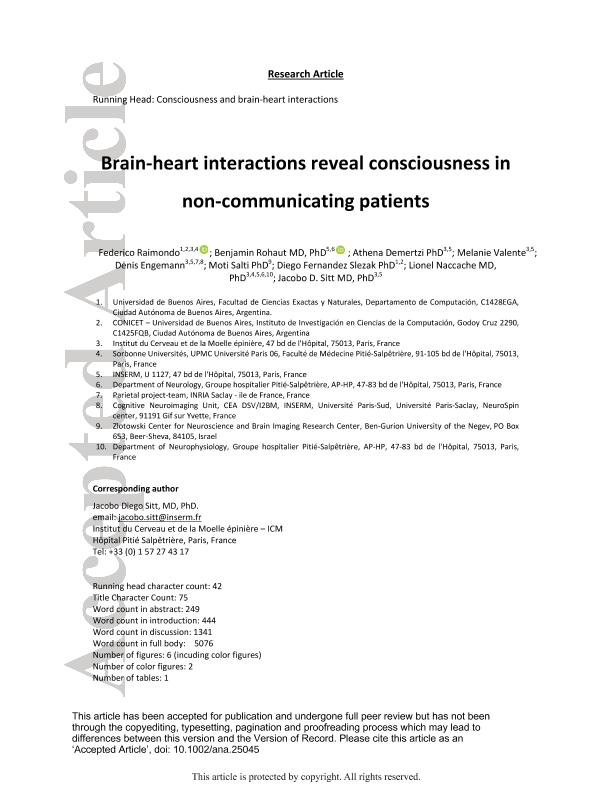Artículo
Brain–heart interactions reveal consciousness in noncommunicating patients
Raimondo, Federico ; Rohaut, Benjamin; Demertzi, Athena; Valente, Melanie; Engemann, Denis; Salti, Moti; Fernandez Slezak, Diego
; Rohaut, Benjamin; Demertzi, Athena; Valente, Melanie; Engemann, Denis; Salti, Moti; Fernandez Slezak, Diego ; Naccache, Lionel; Sitt, Jacobo Diego
; Naccache, Lionel; Sitt, Jacobo Diego
 ; Rohaut, Benjamin; Demertzi, Athena; Valente, Melanie; Engemann, Denis; Salti, Moti; Fernandez Slezak, Diego
; Rohaut, Benjamin; Demertzi, Athena; Valente, Melanie; Engemann, Denis; Salti, Moti; Fernandez Slezak, Diego ; Naccache, Lionel; Sitt, Jacobo Diego
; Naccache, Lionel; Sitt, Jacobo Diego
Fecha de publicación:
10/2017
Editorial:
Wiley-liss, Div John Wiley & Sons Inc
Revista:
Annals Of Neurology
ISSN:
0364-5134
Idioma:
Inglés
Tipo de recurso:
Artículo publicado
Clasificación temática:
Resumen
Objective: We here aimed at characterizing heart–brain interactions in patients with disorders of consciousness. We tested how this information impacts data-driven classification between unresponsive and minimally conscious patients. Methods: A cohort of 127 patients in vegetative state/unresponsive wakefulness syndrome (VS/UWS; n = 70) and minimally conscious state (MCS; n = 57) were presented with the local–global auditory oddball paradigm, which distinguishes 2 levels of processing: short-term deviation of local auditory regularities and global long-term rule violations. In addition to previously validated markers of consciousness extracted from electroencephalograms (EEG), we computed autonomic cardiac markers, such as heart rate (HR) and HR variability (HRV), and cardiac cycle phase shifts triggered by the processing of the auditory stimuli. Results: HR and HRV were similar in patients across groups. The cardiac cycle was not sensitive to the processing of local regularities in either the VS/UWS or MCS patients. In contrast, global regularities induced a phase shift of the cardiac cycle exclusively in the MCS group. The interval between the auditory stimulation and the following R peak was significantly shortened in MCS when the auditory rule was violated. When the information for the cardiac cycle modulations and other consciousness-related EEG markers were combined, single patient classification performance was enhanced compared to classification with solely EEG markers. Interpretation: Our work shows a link between residual cognitive processing and the modulation of autonomic somatic markers. These results open a new window to evaluate patients with disorders of consciousness via the embodied paradigm, according to which body–brain functions contribute to a holistic approach to conscious processing. Ann Neurol 2017;82:578–591.
Palabras clave:
Heart Beat
,
Machine Learning
,
Artificial Intelligence
Archivos asociados
Licencia
Identificadores
Colecciones
Articulos(ICC)
Articulos de INSTITUTO DE INVESTIGACION EN CIENCIAS DE LA COMPUTACION
Articulos de INSTITUTO DE INVESTIGACION EN CIENCIAS DE LA COMPUTACION
Articulos(OCA CIUDAD UNIVERSITARIA)
Articulos de OFICINA DE COORDINACION ADMINISTRATIVA CIUDAD UNIVERSITARIA
Articulos de OFICINA DE COORDINACION ADMINISTRATIVA CIUDAD UNIVERSITARIA
Citación
Raimondo, Federico; Rohaut, Benjamin; Demertzi, Athena; Valente, Melanie; Engemann, Denis; et al.; Brain–heart interactions reveal consciousness in noncommunicating patients; Wiley-liss, Div John Wiley & Sons Inc; Annals Of Neurology; 82; 4; 10-2017; 578-591
Compartir
Altmétricas



